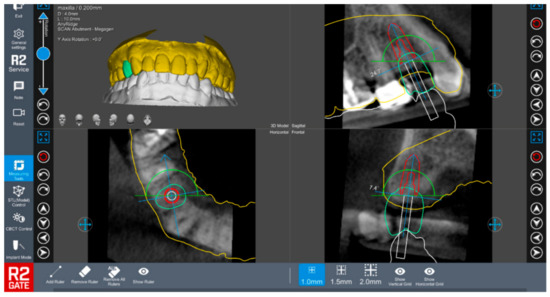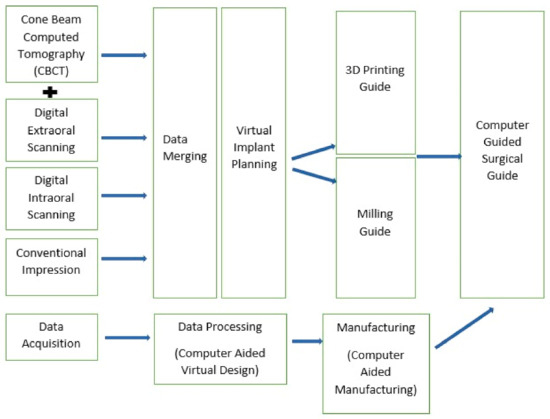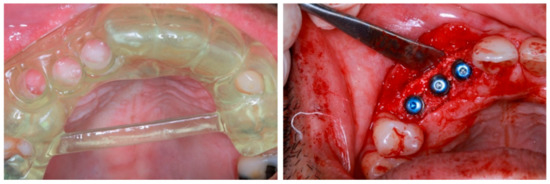Artificial Intelligence (AI) is the ability of a machine to perform human tasks. It revolves around the ability of a machine, around its own intelligence, to solve problems based on the learning of a specific set of data. The foundation of AI is to increase the ability of machines or its intelligence components to perform tasks with speed, low resources, accuracy, and others [
54,
55]. It will also eliminate human intervention such as potential human error, emotion, and bias, thus, making it a perfect solution for laborious work with increased risk of error. Other potential human symptoms such as fatigue, tiredness, and boredom after a continuous repetitive work are also eliminated [
4]. It cannot be emphasized enough that AI requires advanced machine learning on huge datasets (“big data”) as it utilizes specific algorithm to perform the required works [
56].
The application of AI in dentistry is huge with enormous potential [
56]. In dental radiology, the application of AI by using cone beam computed tomography allows an automated detection of specific landmarks such as in lateral cephalometric view, dental panoramic radiography, and others. The progress is also encouraging through other techniques such as automated detection of caries, periodontal disease, periapical disease, and detection of possible oral disease such as cysts or tumor [
57]. In restorative dentistry, AI has been developed to suggest and detect the presence of dental caries [
57]. The conventional method of the detection of caries includes a combination of visual tactile examinations with special investigations such as dental bitewing radiograph. Nonetheless, the evolution in AI challenges the normal paradigm in caries detection with the utilization of state of the art, multiple varieties of neural networks including convoluted neural network, artificial neural networks, and additional derivatives of neural network architecture such as ResNet 18 and ResNext50 [
58]. A systematic review by Pravos-Privado et al. showed that despite the advancement of AI systems in caries detection, various heterogeneity aspects such as parameters, multiple neural network systems, and outcome complicates the accuracy, diagnostics performance, specificity, and sensitivity of AI in caries detection [
59]. Another study by Hung et al. proved that machine learning can be utilized for root caries prediction and prognostic value on a large mass of population data using numerous demographics, general and oral health, social, and lifestyle variables [
60]. Another machine learning algorithm, support vector machine (SVM) showed high predictability and accuracy in assessing the level of complexity of root canal treatments based on American Association of Endodontics Case Difficulty Assessment Forms and thus, are able to aid the classification, clinical cognitive decision by the clinician, and the overall rapid referral process done by general dental practitioners [
61]. In an endodontics diagnostics procedure, the advancement of AI was utilized to detect the periapical pathology by using a prototype of deep convolutional neural network through mass data from CBCT with a high reliability in comparison with the manual conventional segmentation method [
62]. This is due to the ability of deep learning and convoluted neural network of AI components to segment and integrate the original data from radiographic CBCT views and images which then further coded these formats into a form that can be evaluated later on. The advanced development of computer aided design and computer aided manufacturing also allows software to precisely construct dental prostheses despite complex geometrical shapes and laborious laboratory workflow with the potential of a high risk of error involved [
63]. The dental restoration must be a perfect fit, able to undergo ideal function, and also be aesthetically pleasing. In orthodontics-driven AI, a diagnosis, monitoring, and a specific yet individualized treatment plan is available. The clear aligners are produced based on accurate 3D model scanning and dental models. The AI creates an algorithm in which it can predict and decide future tooth movement, and the necessary pressure to be applied to the teeth with aid and input from the dental practitioner [
64]. AI is designed to facilitate the construction of a surgical guide in specialized software with its major role in detecting the thickness, the height, and the density of the bone based on data acquisition from cone beam computed tomography [
11]. This will facilitate the dental practitioner’s decision on suitable timing and technique for the implant placement. Diagnosis of temporomandibular joint disorders (TMDs) can be detected based primarily on history and signs and symptoms, which are then to be followed by clinical examinations. Theoretically, the collective clinical data of TMDs examinations, if they can be translated into a well-structured and organized computer language, are able to differentiate between absolute TMDs diagnosis and other clinical conditions mimicking TMDs [
65]. A study by Shoukri et al. (2019) showed that the neural networks are able to program and classify the TMDs based on the combination of condylar radiographic imaging utilizing CBCT, biological markers such as saliva, and a variable range of clinical indicators including detailed facial and muscle pain and soreness history, range of mouth opening, and other signs such as headaches [
66].








